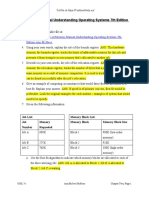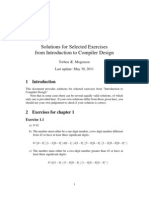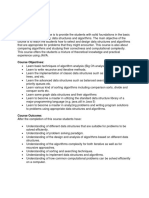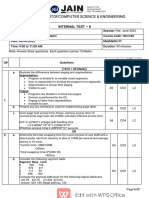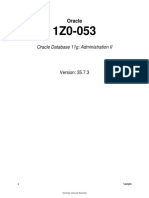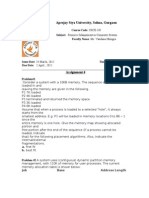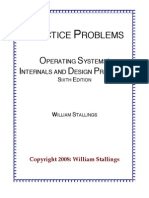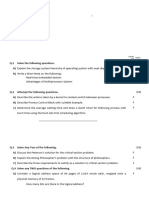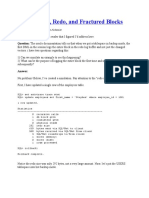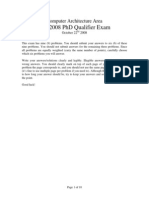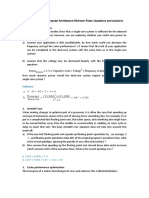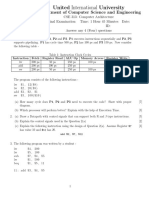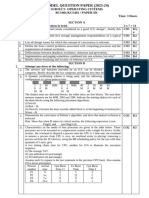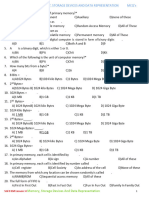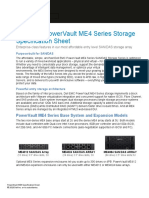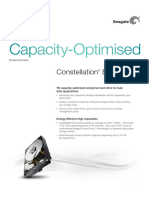Understanding Operating Systems 8th Edition Mchoes Solutions Manual
Understanding Operating Systems 8th Edition Mchoes Solutions Manual
Uploaded by
SarahWilliamsbtskCopyright:
Available Formats
Understanding Operating Systems 8th Edition Mchoes Solutions Manual
Understanding Operating Systems 8th Edition Mchoes Solutions Manual
Uploaded by
SarahWilliamsbtskOriginal Description:
Copyright
Available Formats
Share this document
Did you find this document useful?
Is this content inappropriate?
Copyright:
Available Formats
Understanding Operating Systems 8th Edition Mchoes Solutions Manual
Understanding Operating Systems 8th Edition Mchoes Solutions Manual
Uploaded by
SarahWilliamsbtskCopyright:
Available Formats
Understanding Operating Systems 8th
Edition McHoes Solutions Manual
Visit to Download in Full: https://testbankdeal.com/download/understanding-operating
-systems-8th-edition-mchoes-solutions-manual/
Understanding Operating Systems 8th Edition McHoes Solutions Manual
Exercises, Chap 2
Research Topics (Answers here will vary. Look for originality in the student’s work.)
A. Research the maximum and minimum memory capacity of two models of laptop
computers. Be sure not to confuse the computer’s memory capacity with its secondary
storage. Explain why memory capacity and secondary storage are often confused. Cite
the sources of your research.
B. Identify an example of an online data source that’s used by researchers to advance their
profession. Consider interstellar databases, medical data sources, and so on. Explain
what kinds of data are included in the online source, the researchers who access it, and
scientific advances that may have stemmed from such a resource. Be sure to cite your
sources.
Exercises
1. Consider the first and last memory allocation scheme described in this chapter. Describe
their respective advantages and disadvantages. ANSWER:
Single User Contiguous Relocatable Dynamic Partitions
Advantages Requires minimal Allows multiple jobs in
overhead memory at one time
No external Better use of the CPU
fragmentation Improved use of memory
space
Chapter 2 Exercises Page 1
Visit TestBankDeal.com to get complete for all chapters
Exercises, Chap 2
Resolved external
fragmentation
Disadvantages Does not allow multiple Requires significant
jobs in memory at one overhead for memory
time compaction and job
Poor use of the CPU management
resources
2. In your own words, how often should memory compaction/relocation be performed?
Describe the advantages and disadvantages of performing it even more often than
recommended. (Answer)
We hope every student will have a unique answer to this question, which depends on the cost
of the overhead operation in terms of processing time and use of system resources required
for relocation (such as disk space). The question is designed to encourage students to
speculate on the cost to throughput and system resources of relocation and compaction.
Certainly, if those costs are not taken into consideration, some students might suggest that
relocation be performed very, very often.
3. Give an example of computing circumstances that would favor first-fit allocation over
best-fit. Explain your answer. (Answer: Students should conjure unique examples that
emphasize data writing speed over data retrieval speed. Such circumstance would include
data archival and massive storage of data that will seldom be retrieved. This question is
designed to explore current technologies as they relate to speedy storage of data
elements.)
Chapter 2 Exercises Page 2
Exercises, Chap 2
4. Given the following: configuration with jobs arriving in order (Job A, B, C) and with
blocks shown in order from low order memory to high order memory:
[Start UNT-p.53-1 here] Editor: these should appear as 2 tables
Job List: Memory Block List:
Job Memory Memory Block Memory Block
Number Requested Size
Job A 990K Block 1 900K
Job B 275K Block 2 960K
Job C 760K Block 3 300K
[End UNT-p.53-1 here]
a. Use the first-fit algorithm to indicate which memory blocks are allocated to each of
the arriving jobs. ANSWER: Block 1 gets Job B, Block 2 gets Job C. Job A is not
processed because it is too large for any of the memory blocks.
b. Use the best-fit algorithm to indicate which memory blocks are allocated to each of
the arriving jobs. ANSWER: Block 3 gets Job C, Block 1 gets Job C. Job A is not
processed because it is too large for any of the memory blocks.
c. Calculate the amount of internal fragmentation in Block 1 using the first-fit
algorithm. ANSWER: Using first-fit, Block 1 (900K) is allocated to Job B (275K) so
the fragmentation is 900 – 275 = 625K.
Chapter 2 Exercises Page 3
Exercises, Chap 2
5. Given the following configuration with jobs arriving in order (Job A, B, C, D) and with
blocks shown in order from low order memory to high order memory:
[Start UNT-p.53-2 here] Editor: these should appear as 2 tables
Job List: Memory Block List:
Job Number Memory Memory Block Memory
Requested Block Size
Job A 256K Block 1 910K
Job B 900K Block 2 900K
Job C 50K Block 3 200K
Job D 350K Block 4 300K
[End UNT-p.53-2 here]
a. Use the best-fit algorithm to indicate which memory blocks are allocated to each of
the arriving jobs.
ANSWER:
Job A (256K) gets Block 4 (300K)
Job B (900K) gets Block 2 (900K)
Job C (50K) gets Block 3 (200K)
Job D (350K) gets Block 1 (910K)
b. Use the first-fit algorithm to indicate which memory blocks are allocated to each of
the arriving jobs.
ANSWER:
Chapter 2 Exercises Page 4
Exercises, Chap 2
Job A (256K) gets Block 1, Job B (900K) gets Block 2.
Job C (50K) gets Block 3.
Job D is not processed immediately because it is too large for the last available block
(which is Block 4). However, it will be processed after either Block 1 or Block 2
become available and is allocated to Job D, which is waiting.
c. Calculate the total amount of internal fragmentation in all four blocks using the best-
fit algorithm.
ANSWER:
o -Block 4 (with Job A) has 44K fragmentation.
o -Block 2 (with Job B) has zero fragmentation because the job and block are the
same size, 900K.
o -Block 3 (with Job C) has 150K in fragmentation.
o -Block 1 (with Job D) has 560K in fragmentation.
o -Total fragmentation for all four blocks (44+0+150+560) is 754K.
6. Next-fit is an allocation algorithm that starts by using the first-fit algorithm but it keeps
track of the partition that was last allocated so that it can start its next search from that
exact spot instead of restarting the search with Block 1. In other words, it starts searching
from the most recently allocated block when the next job arrives. Using the following
configuration with jobs arriving in order (Job A, B, C, D) and with blocks shown in order
from low order memory to high order memory:
Chapter 2 Exercises Page 5
Exercises, Chap 2
[Start UNT-p.54-1 here] Editor: these should appear as 2 side-by-side tables
Job List: Memory Block List:
Job Memory Memory Block Memory Block Size
Number Requested
Job A 625K Block 1 250K
Job B 44K Block 2 900K
Job C 900K Block 3 280K
Job D 220K Block 4 200K
Block 5 50K
[End UNT-p.54-1 here]
(a) Indicate which memory blocks are allocated to each of the arriving jobs. ANSWER:
-Job A (625K) doesn’t fit into Block 1 and so gets Block 2 (900K).
-When Job B (44K) arrives, it does not get Block 1 (250K) because the next-fit
system chooses the next block after the one most recently allocated, which is Block 2.
Therefore, Job B gets Block 3 (280K).
-Job C cannot be allocated and so has to wait because it is very large and the only
block that’s large enough (Block 2) has already been allocated to Job A. At this point,
the last allocated job is Block 3 so the next incoming job,
-Job D, is allocated to the next block that’s large enough to hold it, Block 1 (250K).
-Later, when Job A is done, Block 2 can be allocated to the waiting Job C.
Chapter 2 Exercises Page 6
Exercises, Chap 2
(b) Explain in your own words what advantages the next-fit algorithm could offer.
ANSWER: This allocation scheme is designed to make processing time more efficient
but does not necessarily reduce fragmentation. It would also allocate the blocks at the
bottom of the list more often that first-fit or best-fit, both of which begin searching for
available blocks from the first block.
7. Worst-fit is an allocation algorithm that allocates the largest free block to a new job. It is
the opposite of the best-fit algorithm. Using the following configuration with jobs
arriving in order (Job A, B, C, D) and with blocks shown in order from low order
memory to high order memory:
[Start UNT-p.54-1 here] Editor: these should appear as 2 side-by-side tables
Job List: Memory Block List:
Job Memory Memory Block Memory Block Size
Number Requested
Job A 44K Block 1 250K
Job B 220K Block 2 900K
Job C 670K Block 3 280K
Job D 64K Block 4 200K
Block 5 750K
[End UNT-p.54-1 here]
a) Indicate which memory blocks are allocated to each of the arriving jobs.
ANSWER:
Chapter 2 Exercises Page 7
Exercises, Chap 2
-Job A (44K) will be allocated to the biggest available block, Block 2 (900K).
- Then Job B (220K) will get the biggest available block, Block 5 (750K).
-Job C (670K) will need to wait until a block that’s large enough (Blocks 2 or 5) becomes
available.
-Job D (64K) will be allocated Block 3 because it’s the largest one available of the five
blocks.
b) In this chapter we introduced external and internal fragmentation. Explain in your own
words which one would be expected in a worst-fit memory allocation scheme
ANSWER: The worst-fit memory allocation scheme lends itself to internal fragmentation
because the blocks allocated to the incoming jobs can be much larger than necessary, causing
wasted space within the block (internal fragmentation) and not between blocks (external
fragmentation).
8. Imagine an operating system that cannot perform memory deallocation. Name at least
three effects on overall system performance that might result and explain your answer.
(Answer)
Answers here will vary but could include the following. This question could invite a
discussion of the problem of “memory leaks” where an application releases some but not all
allocated memory space (this is a subject not discussed in this text).
• It would run out of available memory as soon as each available memory location was
used once. Memory could never be reused by another program.
• If the only way to clear memory was to reboot, then the system would need to be
rebooted often.
• Such a system would need vast memory reserves to work.
• Such a system would encourage the development of applications that needed very small
memory resources.
Chapter 2 Exercises Page 8
Exercises, Chap 2
9. In a system using the relocatable dynamic partitions scheme, given the following
situation (and using decimal form): Job Q is loaded into memory starting at memory
location 42K.
a. Calculate the exact starting address for Job Q in bytes. Answer: 43008 (42*1024 =
43008)
b. If the memory block has 3K in fragmentation, calculate the size of the memory block.
Answer: 46080 (3*1024 = 3072) + (42*1024 = 43008) = 46080
c. Is the resulting fragmentation internal or external? Explain your reasoning. Answer:
Look for a fundamental understanding of the differences between internal and external
fragmentation.
10. In a system using the relocatable dynamic partitions scheme, given the following
situation (and using decimal form): Job W is loaded into memory starting at memory
location 5000K.
a. Calculate the exact starting address for Job W in bytes. Answer: 5120000 (5000*1024 =
5120000)
b. If the memory block has 3K in fragmentation, calculate the size of the memory block.
Answer: 5130240 (10*1024 = 10240) + (5000*1024 = 5120000) = 5130240
c. Is the resulting fragmentation internal or external? Explain your reasoning. Answer: Look
for a fundamental understanding of the differences between internal and external
fragmentation.
11. Using your own words, explain the role of the bounds register.
Answer: This hardware element, the bounds register, tracks the limits of addressable memory
for this job and prevents it from trying to access memory that’s allocated to another job.
Chapter 2 Exercises Page 9
Exercises, Chap 2
12. Describe in your own words the role of the relocation register.
Answer: This hardware element, the relocation register, tracks the number of bytes
that a job has been moved in main memory as a result of memory compaction. It is
used to track each instruction so it can be found successfully after the job’s relocation
13. If the relocation register holds the value -83968, was the relocated job moved toward
lower or higher addressable end of main memory? Answer: It was moved toward the
lower addressable end of memory) By how many kilobytes was it moved? Answer: It was
moved 82K (-83968 / 1024 = -82) Explain your conclusion. Students should explain how
they reached their conclusion by showing their work.
14. In a system using the fixed partitions memory allocation scheme, given the following
situation (and using decimal form): After Job J is loaded into a partition of size 50K, the
resulting fragmentation is 7168 bytes. Perform the following:
a. What is the size of Job J in bytes? Answer: Job J is 44032 bytes (50*1024 = 51200) –
7168 = 44032 bytes
b. What type of fragmentation is caused? Answer: Internal fragmentation
15. In a system using the dynamic partition memory allocation scheme, given the following
situation (and using decimal form): After Job C of size 70K is loaded into a partition resulting
in 7K of fragmentation, calculate the size (in bytes) of its partition (Answer: 71680
(70*1024 = 71680) and identify the type of fragmentation that is caused (External
fragmentation). Explain your answer. (Students should show their calculations and
explain how they know that the fragmentation is between partitions indicating external
fragmentation and not within partitions, which would indicate internal fragmentation.)
Chapter 2 Exercises Page 10
Exercises, Chap 2
Advanced Exercises
16. The relocation example presented in the chapter implies that compaction is done entirely
in memory, without secondary storage. Can all free sections of memory be merged into
one contiguous block using this approach? Why or why not?
(see attached document for answer to 2-16)
17. In this chapter we described one of several ways to compact memory. Some people suggest an
alternate method: all jobs could be copied to a secondary storage device and then reloaded (and
relocated) contiguously into main memory, thus creating a single free block after all jobs have
been recopied into memory. Is this viable? Could you devise a better way to compact memory?
Write your algorithm and explain why it is better. (Answer: This type of compaction may prove to
be more time consuming than the previous one because it requires access to a secondary storage
device. If the operating system and computer are equipped with "block" transfer and buffers
(these are discussed later in the text), then the transfer time could be optimized. In addition, if
the disk was a device dedicated only to compaction, then its hardware components could also be
set to optimize the seek time. When using secondary storage one needs to remember that a
store and load operation are performed every time increasing the time needed to complete
compaction.
18. Given the memory configuration in Figure 2.10 below, answer the following questions given
that at this point, Job 4 arrives requesting a block of 100K.
a. Can Job 4 (100K) be accommodated? Why or why not? ANSWER: Job 4 cannot be
accommodated because there is not enough contiguous free memory available.
b. If relocation is used, after memory compaction, what are the contents of the
relocation registers for Job 1, Job 2, and Job 3? ANSWER:
Contents of Relocation Registers Job Number
0 1
-20480 (-20K) 2
-30720 (-30K) 3
Chapter 2 Exercises Page 11
Exercises, Chap 2
c. What are the contents of the relocation register for Job 4 after it has been loaded into
memory? Answer: The relocation register for Job 4 is set to zero because it has just
been loaded into memory.
d. An instruction that is part of Job 1 was originally loaded into memory location 22K.
What is its new location after compaction? Answer Its location has not changed
because Job 1 has not been relocated.
e. An instruction that is part of Job 2 was originally loaded into memory location 55K.
What is its new location after compaction? Answer Its location is: 55K - 20K = 35K
(or 35840)
f. An instruction that is part of Job 3 was originally loaded into memory location 80K.
What is its new location after compaction? Answer Its location is: 80K - 30K = 50K
(or 51200)
g. If an instruction was originally loaded into memory location 110K, what is its new
location after compaction? Answer: Its location is: 110K - 30K = 80K (or 81920)
Programming Exercises
19. Here is a long-term programming project. Use the information that follows to complete
this exercise.
[Start UNT-p.56-1 here]
Job List
Job Stream Number Time Job Size
1 5 5760
Chapter 2 Exercises Page 12
Exercises, Chap 2
2 4 4190
3 8 3290
4 2 2030
5 2 2550
6 6 6990
7 8 8940
8 10 740
9 7 3930
10 6 6890
11 5 6580
12 8 3820
13 9 9140
14 10 420
15 10 220
16 7 7540
17 3 3210
18 1 1380
19 9 9850
Chapter 2 Exercises Page 13
Exercises, Chap 2
20 3 3610
21 7 7540
22 2 2710
23 8 8390
24 5 5950
25 10 760
[End UNT-p.56-1 here]
[Start UNT-p.56-2 here]
Memory List
Memory Block Size
1 9500
2 7000
3 4500
4 8500
5 3000
6 9000
7 1000
8 5500
9 1500
Chapter 2 Exercises Page 14
Exercises, Chap 2
10 500
[End UNT-p.56-2 here]
At one large batch-processing computer installation, the management wants to decide what
storage placement strategy will yield the best possible performance. The installation runs a
large real storage computer (as opposed to “virtual” storage, which is covered in Chapter 3)
under fixed partition multiprogramming. Each user program runs in a single group of
contiguous storage locations. Users state their storage requirements and time units for CPU
usage on their Job Control Card (it used to, and still does, work this way, although cards may
not be used). The operating system allocates to each user the appropriate partition and starts
up the user’s job. The job remains in memory until completion. A total of 50,000 memory
locations are available, divided into blocks as indicated in the previous table.
a. Write (or calculate) an event-driven simulation to help you decide which storage
placement strategy should be used at this installation. Your program would use the job
stream and memory partitioning as indicated previously. Run the program until all jobs
have been executed with the memory as is (in order by address). This will give you the
first-fit type performance results.
b. Sort the memory partitions by size and run the program a second time; this will give
you the best-fit performance results. For both parts a. and b., you are investigating the
performance of the system using a typical job stream by measuring:
1. Throughput (how many jobs are processed per given time unit)
2. Storage utilization (percentage of partitions never used, percentage
of partitions heavily used, and so on)
Chapter 2 Exercises Page 15
Exercises, Chap 2
3. Waiting queue length
4. Waiting time in queue
5. Internal fragmentation
Given that jobs are served on a first-come, first-served basis:
c. Explain how the system handles conflicts when jobs are put into a waiting queue and
there are still jobs entering the system—which job goes first?
d. Explain how the system handles the “job clocks,” which keep track of the amount of
time each job has run, and the “wait clocks,” which keep track of how long each job
in the waiting queue has to wait.
e. Since this is an event-driven system, explain how you define “event” and what
happens in your system when the event occurs.
f. Look at the results from the best-fit run and compare them with the results from the
first-fit run. Explain what the results indicate about the performance of the system for
this job mix and memory organization. Is one method of partitioning better than the
other? Why or why not? Could you recommend one method over the other given your
sample run? Would this hold in all cases? Write some conclusions and
recommendations.
20. Suppose your system (as explained in Exercise 19) now has a “spooler” (a storage area in
which to temporarily hold jobs), and the job scheduler can choose which will be served
from among 25 resident jobs. Suppose also that the first-come, first-served policy is
replaced with a “faster-job, first-served” policy. This would require that a sort by time be
performed on the job list before running the program. Does this make a difference in the
results? Does it make a difference in your analysis? Does it make a difference in your
Chapter 2 Exercises Page 16
Exercises, Chap 2
conclusions and recommendations? The program should be run twice to test this new
policy with both best-fit and first-fit.
21. Suppose your spooler (as described in the previous exercise) replaces the previous policy
with one of “smallest-job, first-served.” This would require that a sort by job size be
performed on the job list before running the program. How do the results compare to the
previous two sets of results? Will your analysis change? Will your conclusions change?
The program should be run twice to test this new policy with both best-fit and first-fit.
Answers to 19, 20, 21: The three Programming Exercises are best explained during a few class
sessions using a sample paper-and-pencil model to highlight the structure of the program modules
and their interrelationships. Sample outputs are very helpful to the students as well as a sample of
the analysis that can be performed on the data collected.
Typically, the procedures used in the simulation are:
i. Main Procedure: contains the calls to all other procedures.
ii. Input Procedure: where all data is submitted.
iii. Time Procedure: where the system clock is updated to indicate how long it took to process all
jobs and where the time to run a job (job clock) is updated.
iv. Waiting Procedure: used if a job is put on a waiting queue. The job's waiting clock is updated
and the waiting queue count is increased.
v. Snapshot Procedure: used to print out the status of the job table and the memory table at
even intervals. This gives a good trace of how the system is behaving.
vi. Winding Procedure: used to handle all jobs still active or waiting after there are no more
incoming jobs.
vii. Statistics Procedure: used to produce the typical measures requested by the exercise.
A policy has to be developed to handle the conflict of which job will be served first: the one in the
waiting queue or the incoming one. A related policy must be defined to determine whether no more
incoming jobs will be accepted until the ones in the waiting queue are served or the system will flip-
flop between incoming and waiting jobs.
Chapter 2 Exercises Page 17
Exercises, Chap 2
The data for the jobs is best stored into a table with columns indicating: job size, job time to run,
waiting time and status (new, running, waiting, too big or done). The data for the memory blocks is
best stored into a table with columns indicating: block size, status (busy or free), number of jobs
currently using block, counter for number of times block has been used.
Sample Snapshot:
Job Table
Job Wait Completion
Number Run Time Job Size Job Status Time Time
01 05 576 done 00 05
02 04 419 done 00 04
03 08 329 done 00 08
04 02 203 done 00 02
05 02 255 done 00 02
06 06 699 done 00 06
07 08 894 running 00
08 10 074 running 00
09 07 393 running 00
10 06 689 running 01
11 05 658 waiting 03
12 08 382 running 00
13 09 914 new
14 10 042 new
15 10 022 new
16 07 754 new
17 03 321 new
18 01 138 new
19 09 985 new
20 03 361 new
21 07 754 new
Chapter 2 Exercises Page 18
Understanding Operating Systems 8th Edition McHoes Solutions Manual
Exercises, Chap 2
22 02 271 new
23 08 839 new
24 05 595 new
25 10 076 new
Memory Table
Block Block Block Job Number of Internal
Number Size Status Number Times Used Fragmentation
01 950 busy 10 3 261
02 700 busy 08 2 626
03 450 busy 12 2 068
04 850 busy 2 457
05 300 free 1
06 900 busy 07 1 006
07 100 free
08 550 free
09 150 free
10 050 free
Chapter 2 Exercises Page 19
Visit TestBankDeal.com to get complete for all chapters
You might also like
- Essential Calculus Early Transcendentals 2nd Edition Stewart Solutions ManualDocument16 pagesEssential Calculus Early Transcendentals 2nd Edition Stewart Solutions Manualvaleriefishersefkgtmrqi100% (19)
- Electronics Fundamentals A Systems Approach 1st Edition Floyd Solutions ManualDocument11 pagesElectronics Fundamentals A Systems Approach 1st Edition Floyd Solutions ManualDanaGonzalezqietn100% (14)
- Guide To Network Defense and Countermeasures 3rd Edition Weaver Test BankDocument8 pagesGuide To Network Defense and Countermeasures 3rd Edition Weaver Test BankJillianMontoyasepza100% (16)
- Computer Organization and Design Mips Edition 5th Edition Patterson Solutions ManualDocument9 pagesComputer Organization and Design Mips Edition 5th Edition Patterson Solutions Manualmatthewmorrisonsmwqkifnjx94% (17)
- Gaddis Starting Out With C++ 8th Solution of Check PointsDocument31 pagesGaddis Starting Out With C++ 8th Solution of Check Pointsعبد للهNo ratings yet
- Solution Manual Understanding Operating Systems 7th Edition Ann McHoesDocument10 pagesSolution Manual Understanding Operating Systems 7th Edition Ann McHoesmikeNo ratings yet
- Dell PowerProtect DD Concepts and Features - Participant GuideDocument76 pagesDell PowerProtect DD Concepts and Features - Participant GuideMWANAHAWA BAKARINo ratings yet
- Introduction To Compiler Design - SolutionsDocument23 pagesIntroduction To Compiler Design - Solutionsmonroe1010% (1)
- Tutorial 2Document3 pagesTutorial 2Elena WilliamNo ratings yet
- Discuss How The Following Pairs of Scheduling Criteria Conflict in Certain SettingsDocument13 pagesDiscuss How The Following Pairs of Scheduling Criteria Conflict in Certain SettingsSushma ShirodkarNo ratings yet
- Electronic Devices and Circuit Theory 11th Edition Boylestad Test BankDocument10 pagesElectronic Devices and Circuit Theory 11th Edition Boylestad Test Bankjessicataylorqcpdbkxsat100% (16)
- MCQ DBMSDocument448 pagesMCQ DBMSShivam SuryawanshiNo ratings yet
- MCQDocument3 pagesMCQmanaliNo ratings yet
- Data Structures: Course ObjectivesDocument3 pagesData Structures: Course ObjectivesMunawar JamalNo ratings yet
- CSS MCQDocument6 pagesCSS MCQSara Akbari100% (1)
- DBMS MCQ BankDocument96 pagesDBMS MCQ BankRamkishan ShindeNo ratings yet
- DIT 202 Computer Architecture & OrganizationDocument2 pagesDIT 202 Computer Architecture & OrganizationJosephine TorresNo ratings yet
- Automata Theory E-Content DocumentDocument100 pagesAutomata Theory E-Content Documentjhoronamohanty100% (1)
- Core Java MCQ 1Document465 pagesCore Java MCQ 1NikhitaNo ratings yet
- DBMS NotesDocument18 pagesDBMS NotesYamanNo ratings yet
- Database Normalization Explain 1NF 2NF 3NF BCNF With Examples PDFDocument9 pagesDatabase Normalization Explain 1NF 2NF 3NF BCNF With Examples PDFRaj ShahNo ratings yet
- Dwnload Full Understanding Operating Systems 7th Edition Mchoes Solutions Manual PDFDocument35 pagesDwnload Full Understanding Operating Systems 7th Edition Mchoes Solutions Manual PDFnanurunyuta9100% (14)
- Tutorial Chapter 2Document4 pagesTutorial Chapter 2Voon Rou NgNo ratings yet
- Seatwork 1 - Memory ManagementDocument2 pagesSeatwork 1 - Memory ManagementRyan OlaybalNo ratings yet
- Exercise 2 Memory ManagementDocument2 pagesExercise 2 Memory ManagementMayank GargNo ratings yet
- 01 Homework cs4448Document4 pages01 Homework cs4448Dinh NamNo ratings yet
- CSF204 CS214 OS Garima End Garima Verma MDocument2 pagesCSF204 CS214 OS Garima End Garima Verma Mshivangi SinghNo ratings yet
- OS IA 2 Scheme Ad SolutionDocument6 pagesOS IA 2 Scheme Ad Solutionmd shakil ahsan mazumderNo ratings yet
- HMK 4 ARCDocument3 pagesHMK 4 ARCskeletorfearsmeNo ratings yet
- Topic 2 Part 1Document32 pagesTopic 2 Part 1Amirul AdamNo ratings yet
- Section-A: Time: 2 Hours. Date of ExaminationDocument2 pagesSection-A: Time: 2 Hours. Date of ExaminationAnuj KumarNo ratings yet
- Chapter5 Memory ManagementDocument78 pagesChapter5 Memory ManagementJackYuan JinFengNo ratings yet
- Seatwork 2Document1 pageSeatwork 2Roh MerNo ratings yet
- OS Activity - Jayvee-Bugay-BSIT-2ADocument5 pagesOS Activity - Jayvee-Bugay-BSIT-2AEmil DegalaNo ratings yet
- Oracle: Oracle Database 11g: Administration IIDocument8 pagesOracle: Oracle Database 11g: Administration IIvcvNo ratings yet
- OS Lecture 7Document43 pagesOS Lecture 7Md Masum BillahNo ratings yet
- Assignment 4 For StudentsDocument3 pagesAssignment 4 For StudentstighraNo ratings yet
- Ractice Roblems O S: I D P: Perating Ystems Nternals and Esign Rinciples S EDocument28 pagesRactice Roblems O S: I D P: Perating Ystems Nternals and Esign Rinciples S EHamza Asim Ghazi100% (1)
- CST232 Tutorial2Document2 pagesCST232 Tutorial2VortexProYeoNo ratings yet
- Assignment 5 NPTEL DBMS January 2024Document10 pagesAssignment 5 NPTEL DBMS January 2024no.reply15203No ratings yet
- Solution 3Document12 pagesSolution 3Herman KombaNo ratings yet
- 2003 Test and AnswersDocument5 pages2003 Test and AnswersBelete BelayNo ratings yet
- Operating Systems - 12-01-2023Document2 pagesOperating Systems - 12-01-2023RahulNo ratings yet
- Btech Cs 4 Sem Operating System ncs401 2019Document2 pagesBtech Cs 4 Sem Operating System ncs401 2019Vishal Kumar SharmaNo ratings yet
- Ops611s - Operating Systems - 2ND Opp - July 2022Document8 pagesOps611s - Operating Systems - 2ND Opp - July 2022Gerald KufangaNo ratings yet
- Sem 4 - Minor 1Document5 pagesSem 4 - Minor 1Shashank Mani TripathiNo ratings yet
- hệ điều hànhDocument18 pageshệ điều hànhfranklampardnumber8No ratings yet
- CSOE41Document2 pagesCSOE41TejNo ratings yet
- Hot Backups, Redo, and Fractured BlocksDocument11 pagesHot Backups, Redo, and Fractured Blocksjklakra25No ratings yet
- RT31055102020Document2 pagesRT31055102020elisha emilianNo ratings yet
- Operating System Homework-3: Submitted byDocument12 pagesOperating System Homework-3: Submitted bySuraj SinghNo ratings yet
- Ex 11Document10 pagesEx 11Siam HasanNo ratings yet
- IITD Exam SolutionDocument9 pagesIITD Exam SolutionRohit JoshiNo ratings yet
- Fall 2008 PHD Qualifier Exam: Computer Architecture AreaDocument10 pagesFall 2008 PHD Qualifier Exam: Computer Architecture AreaNguyen Van HuyNo ratings yet
- MidtermsolutionsDocument3 pagesMidtermsolutionsRajini GuttiNo ratings yet
- MCSL 045Document43 pagesMCSL 045Shubbyy ChanNo ratings yet
- Unrestricted and Restricted Topology Optimization of A PlateDocument30 pagesUnrestricted and Restricted Topology Optimization of A Plate276763420No ratings yet
- 172 CSE313 FinalDocument3 pages172 CSE313 FinalSabbir HossainNo ratings yet
- Model QP - BCS401Document3 pagesModel QP - BCS401km952838No ratings yet
- Operating Systems: Here Are The Topics Covered and Their Approximate Importance On The TestDocument4 pagesOperating Systems: Here Are The Topics Covered and Their Approximate Importance On The TestEngr Asif Usman KhattakNo ratings yet
- Compre 1Document3 pagesCompre 1f20213196No ratings yet
- Cloud Price Comparison - AWS Vs Azure Vs GoogleDocument35 pagesCloud Price Comparison - AWS Vs Azure Vs GooglepraveenindayNo ratings yet
- Specialist - Implementation Engineer, Dell EMC Unity Solutions Version 2.0Document4 pagesSpecialist - Implementation Engineer, Dell EMC Unity Solutions Version 2.0Krishna Yadav0% (1)
- G11 - Module 2Document19 pagesG11 - Module 2Daniel Daryl CalingNo ratings yet
- Swapping and SegmentationDocument15 pagesSwapping and SegmentationUsama RaheemNo ratings yet
- User's Guide: IBM Electronic Journal For 4690 OS, Version 2Document72 pagesUser's Guide: IBM Electronic Journal For 4690 OS, Version 2YavuzNo ratings yet
- Greedy Page Replacement Algorithm For Flash-Aware Swap SystemDocument6 pagesGreedy Page Replacement Algorithm For Flash-Aware Swap SystemTenma InazumaNo ratings yet
- Cloud Computing ArchitectureDocument16 pagesCloud Computing ArchitectureJay ChhatrolaNo ratings yet
- std9 ch4Document9 pagesstd9 ch4Ilesh ShahNo ratings yet
- h17384 Powervault Me4 Series SsDocument5 pagesh17384 Powervault Me4 Series SsAnthony ThomasNo ratings yet
- 302-000-318 Emx VNXDocument23 pages302-000-318 Emx VNXEricson R N'GUESSANNo ratings yet
- Linux LVM Interview Questions & AnswerDocument5 pagesLinux LVM Interview Questions & AnswerNirav DesaiNo ratings yet
- Veeam Backup 9 5 U4 Tapes User GuideDocument146 pagesVeeam Backup 9 5 U4 Tapes User GuidenomanNo ratings yet
- Introduction To Computer Ch-04Document51 pagesIntroduction To Computer Ch-04Mian AbdullahNo ratings yet
- Itm Computer FundamentalsDocument26 pagesItm Computer FundamentalsSyed Zaffar NiazNo ratings yet
- Security Audit ChecklistDocument5 pagesSecurity Audit ChecklistGeneva Dulagan100% (2)
- Constellation Es 3 Po0105 1 1210gbDocument2 pagesConstellation Es 3 Po0105 1 1210gbhaibin qiNo ratings yet
- SAP Memory ManagementDocument11 pagesSAP Memory ManagementShobhit GargNo ratings yet
- Research Paper On 3d Optical Data StorageDocument9 pagesResearch Paper On 3d Optical Data Storageskpcijbkf100% (1)
- Innodisk SATADOM-ML 3ME3 DatasheetDocument2 pagesInnodisk SATADOM-ML 3ME3 Datasheetkc9wscNo ratings yet
- 3par Commands Hot SpareDocument14 pages3par Commands Hot SpareAvi KinetNo ratings yet
- Itc TestDocument8 pagesItc TestBenjamin Achilles RobertsonNo ratings yet
- CS3451 OS UNIT 1 NOTES EduEnggDocument34 pagesCS3451 OS UNIT 1 NOTES EduEnggDilip RavikumarNo ratings yet
- Past Paper Worksheet Chapter 3Document4 pagesPast Paper Worksheet Chapter 3Althaf MubinNo ratings yet
- Dxi 6900Document400 pagesDxi 6900Fabrizio GiordanoNo ratings yet
- Netbackup Tips Glossary: CLI Command Line Interface GUI Graphical User Interface Media Server Master ServerDocument27 pagesNetbackup Tips Glossary: CLI Command Line Interface GUI Graphical User Interface Media Server Master Serversantha kumarNo ratings yet
- Nov 21 P1 QPDocument10 pagesNov 21 P1 QPEngr. Shahriar Kabir KhanNo ratings yet
- Nutshell IctDocument7 pagesNutshell IctberringtonhardyNo ratings yet
- OCI Architect 2021 Associate (1Z0-1072-21) Skill Check Sample Question AnswerDocument6 pagesOCI Architect 2021 Associate (1Z0-1072-21) Skill Check Sample Question Answerahmet.sepiolNo ratings yet
- Homework4 v2 SolutionDocument14 pagesHomework4 v2 Solutionrazi haiderNo ratings yet





